Serbia Calendar 2025 - Public & Regional Holiday: Significance and Celebration
15:56 | 10/11/2024 Print
Serbia, a country rich in history, culture, and traditions, observes a variety of public and regional holidays each year. Many of these holidays reflect Serbia’s deep Orthodox Christian roots, its historical milestones, and its vibrant national identity.
In 2025, Serbia’s public holidays provide a mix of solemn commemorations, religious festivities, and cultural celebrations that highlight the nation’s heritage.
Learn more: Europe Calendar 2025 - List of Public Holidays and Celebratio
List of Public Holidays in Serbia 2025: Significance and Celebrations
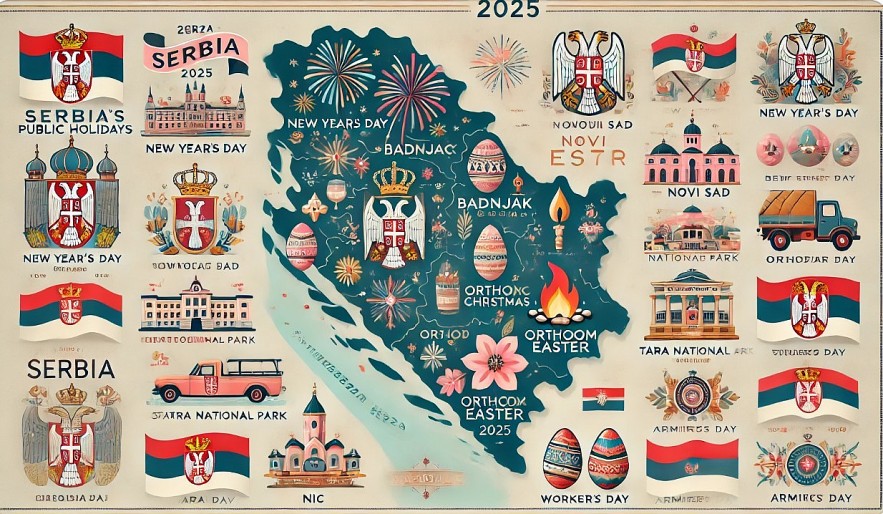 |
| Holidays in Serbia 2025 |
Serbia recognizes 11 official public holidays, which are celebrated nationwide. These holidays often have historical or religious significance and are widely observed across the country.
1. New Year’s Day (Nova Godina)
- Dates: January 1–2, 2025
- Type: Public Holiday (Nationwide)
- Closures: Schools, public offices, and most supermarkets are closed.
- History and Significance:
New Year’s Day marks the beginning of the calendar year. Celebrated in many countries, it holds special significance in Serbia as a time for new beginnings and festive gatherings.
- Celebrations and Activities:
On New Year’s Eve, fireworks illuminate the skies over major cities like Belgrade and Novi Sad. Families and friends gather for festive meals, including traditional dishes like sarma (cabbage rolls) and roasted meats. Many Serbians also exchange gifts during this time.
 Czech Calendar 2025 - List of Public & Regional Holiday: Significance and Activities Czech Calendar 2025 - List of Public & Regional Holiday: Significance and Activities |
2. Orthodox Christmas (Božić)
- Date: January 7, 2025
- Type: Public Holiday (Nationwide)
- Closures: Schools, public offices, and most supermarkets are closed.
- History and Significance:
Celebrated according to the Julian calendar, Orthodox Christmas commemorates the birth of Jesus Christ. It is one of the most significant religious holidays in Serbia.
- Celebrations and Activities:
Christmas Eve, known as Badnje Veče, is marked by the burning of the badnjak (oak branch) as a symbol of prosperity. Families gather for a special meal and exchange greetings of “Mir Božji, Hristos se rodi!” (“God’s peace, Christ is born!”). On Christmas Day, people attend church services and share festive meals.
3. Statehood Day (Dan državnosti)
- Dates: February 15–16, 2025
- Type: Public Holiday (Nationwide)
- Closures: Schools, public offices, and most businesses are closed.
- History and Significance:
Statehood Day marks the beginning of the Serbian Revolution against Ottoman rule in 1804 and the adoption of the first Serbian Constitution in 1835. It celebrates Serbia’s independence and national pride.
- Celebrations and Activities:
Official ceremonies are held at historical sites like Orašac, where the uprising began. Wreaths are laid at monuments, and cultural events such as traditional music and dance performances take place. Families often use the day for outings and picnics.
4. Orthodox Easter (Vaskrs)
- Dates: April 20–21, 2025 (Easter Sunday and Monday)
- Type: Public Holiday (Nationwide)
- Closures: Schools, public offices, and most businesses are closed.
- History and Significance:
Easter celebrates the resurrection of Jesus Christ and is the most important holiday in the Orthodox Christian calendar.
- Celebrations and Activities:
The week leading up to Easter, known as Velika Nedelja (Holy Week), includes church services and fasting. On Easter Sunday, families dye eggs, with the first red egg known as Čuvarkuća (“the guardian of the house”) kept as a symbol of protection. Traditional greetings of “Hristos vaskrse!” (“Christ is risen!”) are exchanged.
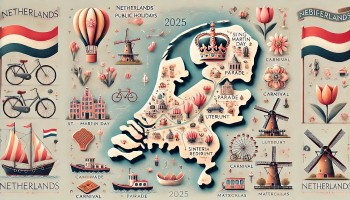 Netherlands Calendar 2025 - List of Public & Regional Holiday: Significance and Celebration Netherlands Calendar 2025 - List of Public & Regional Holiday: Significance and Celebration |
5. International Workers’ Day (Međunarodni praznik rada)
- Dates: May 1–2, 2025
- Type: Public Holiday (Nationwide)
- Closures: Schools, public offices, and supermarkets are closed.
- History and Significance:
Workers’ Day celebrates the achievements of the labor movement. In Serbia, it is also a time for spring festivities.
- Celebrations and Activities:
Families and friends gather for outdoor picnics and barbecues, often in parks or countryside areas. Traditional foods like ćevapi (grilled minced meat) and rakija (fruit brandy) are staples of the celebrations.
6. Armistice Day (Dan primirja)
- Date: November 11, 2025
- Type: Public Holiday (Nationwide)
- Closures: Schools, public offices, and most businesses are closed.
- History and Significance:
Armistice Day commemorates the end of World War I and honors those who fought for Serbia’s freedom.
- Celebrations and Activities:
Ceremonies are held at war memorials, including Belgrade’s Monument to the Unknown Hero. Participants wear symbolic flowers like Natalijina Ramonda (Natalie’s Ramonda), representing remembrance and rebirth.
7. Christmas Eve and Day (Badnji Dan i Božić)
- Date: December 24–25, 2025 (Gregorian calendar Christmas)
- Type: Public Holiday (For minorities in Serbia, observed by Catholics and Protestants)
- Closures: Schools, public offices, and supermarkets may close in regions with Catholic populations.
- History and Significance:
Observed by Catholic and Protestant communities in Serbia, this Christmas celebration commemorates the birth of Jesus Christ.
- Celebrations and Activities:
Midnight masses are held in churches. Families exchange gifts and enjoy festive meals.
Learn more: Top 15 Biggest Festivals and Carnivals in Europe in 2025
Regional and Lesser-Known Holidays in Serbia 2025
-
Vidovdan (St. Vitus Day)
- Date: June 28, 2025
- Type: Observance (Nationwide)
- Significance: Vidovdan commemorates the Battle of Kosovo in 1389 and is a day of historical and spiritual importance.
- Activities: Ceremonies, church services, and discussions about Serbia’s heritage.
-
Slava (Patron Saint Day)
- Date: Varies by family
- Type: Unique Serbian Tradition (Observed throughout the year)
- Significance: A Slava is a family’s annual celebration of its patron saint. It is a deeply personal and cultural event.
- Activities: Families host feasts, attend church, and light candles in honor of their patron saint.
Conclusion
Serbia’s public and regional holidays in 2025 reflect its deep Orthodox Christian traditions, historical milestones, and strong cultural identity. Whether it’s the solemnity of Orthodox Christmas, the patriotic pride of Statehood Day, or the family warmth of Slava celebrations, these holidays provide an opportunity for reflection, celebration, and unity. Visitors to Serbia will find these holidays to be an enriching window into the country’s rich history and traditions.
FAQs
-
What are the most important public holidays in Serbia?
Orthodox Christmas, Statehood Day, and Orthodox Easter are among Serbia’s most significant holidays.
-
Are shops and offices open on public holidays in Serbia?
Most public holidays see closures of schools, public offices, and supermarkets, though some tourist-focused businesses may remain open.
-
What is Slava, and how is it celebrated?
Slava is a unique Serbian tradition where families honor their patron saint with feasts, church visits, and ceremonies.
-
Do all regions of Serbia celebrate the same holidays?
While most holidays are nationwide, regional or religious minorities may observe additional holidays, such as Gregorian Christmas.
-
How is Statehood Day celebrated in Serbia?
Statehood Day is marked with official ceremonies, cultural events, and family outings to celebrate Serbia’s independence and history.
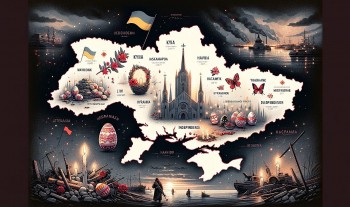 2025 Ukraine Calendar - List of Public Holidays, Observances, Celebrations and Activities 2025 Ukraine Calendar - List of Public Holidays, Observances, Celebrations and Activities This guide provides a comprehensive overview of Ukraine’s national public holidays, observances, and regional traditions in 2025, including their dates, history, significance, and potential impact ... |
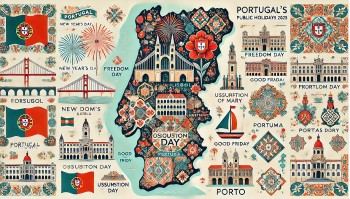 Portugal Calendar 2025 - List of Public Holidays, Significance and Activities Portugal Calendar 2025 - List of Public Holidays, Significance and Activities The dates, background, significance, and celebration activities of Portugal's national public holidays, regional holidays, and distinctive customs for 2025 are all covered in this guide. |
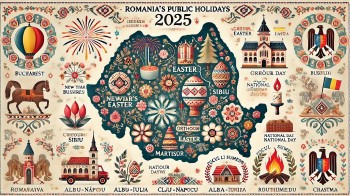 Romania Calendar 2025 - List of Public Holidays: Significance and Celebrations Romania Calendar 2025 - List of Public Holidays: Significance and Celebrations This comprehensive guide provides an overview of public holidays, regional holidays, and important observances in Romania for 2025, including their dates, history, significance, and celebrations. |
 Belgium Calendar 2025 - List of Public Holiday: Significance and Celebration Belgium Calendar 2025 - List of Public Holiday: Significance and Celebration This comprehensive guide explores Belgium’s public holidays, regional observances, and their significance, providing insight into how these special days are celebrated in 2025. |
Larry Mimosa
Article URL: https://knowinsiders.com/serbia-calendar-2025-public-regional-holiday-significance-and-celebration-41149.html
All rights reserved by KnowInsider
